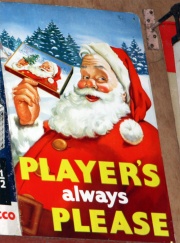John Player and Sons (Player's)
John Player and Sons, known simply as Player's, was a tobacco and cigarette manufacturer, based in Nottingham.
In March 1828, William Wright set up a small tobacco factory in Broadmarsh, Nottingham.
This business expanded and provided William Wright with a comfortable fortune.
1839 John Player was born in Saffron Walden, Essex.
1862 Player began work as a draper's assistant in Nottingham, later setting up a shop as an agricultural manure and seed producers agent. As a sideline, he sold tobacco.
1877 The business was purchased by John Player. He was a man of vision and saw the need for expansion. He built the Castle Tobacco Factories in Radford, Nottingham. He constructed three large factory blocks, but initially only one was used for the production and packaging of tobacco. The other two blocks were let to lace manufacturers, until the business had expanded sufficiently to utilise the additional space.
One of John Player's innovations was to offer pre-packaged tobacco. Prior to this, smokers would have purchased tobacco by weight from loose supplies and cigarette papers to roll them in. He also adopted a registered trade mark as a guarantee to the public that the goods could be relied on.
1877-1927 Various trademarks were registered for the company's products, its most famous one being the head of a sailor, Hero which was first registered in 1883.
1881 Three new factory blocks were built at Radford, Nottingham.
1884 The Castle tobacco factory opened but shortly afterwards John Player died.
The business was run later by his sons, John Dane Player and William Goodacre Player.
1893 John Dane and William Goodacre, Player's sons, took over the running of the business.
1901, in response to competitive threats from the USA, the Player's business was merged with 12 other tobacco companies to become the Imperial Tobacco Co (headquartered in Bristol).
Players cigarettes retained their own identity (in brands such as 'Navy Cut', 'No.6', 'John Player Special' and 'Gold Leaf') with their distinctive logo of a smoking sailor in a 'Navy Cut' cap.
A new factory (the 'Horizon' factory) was opened in the early 1970s on Nottingham's industrial outskirts, with better road access and more effective floor space, placed quite ironically next to the headquarters of Boots the Chemists.
The old factories in Radford (especially the cavernous 'No.1 Factory') were gradually run down and the final demolition of the 'No.3 Factory', with its rooftop 'John Player & Sons' sign, came in the late 1980s.
2008 Player's cigarettes are still manufactured in Nottingham. It is still part of the Imperial Tobacco Group.
No 2 Factory (facing onto Radford Boulevard) was the one with the clock (now plinthed in the Retail park). The Horizon factory ceased production in May 2016 and the building is now for sale.[1]
See Also
Sources of Information
- ↑ Brian L Dominic

















































